Manuscript accepted on :
Published online on: 26-11-2015
Plagiarism Check: Yes
Reza Mohammadi* and Gholamreza Yavari
Payam Noor University, Gohardasht, Karaj, Alborze Province, Iran
DOI : https://dx.doi.org/10.13005/bpj/599
Abstract
This study analyzes the effect of Aggregate Measurement of Support policies on Urban Households’ Food Security Index in Iran applying Auto Regressive Distributed Lag (ARDL) from (1982 – 2012). In order to achieve this goal, Aggregate Households’ Food Security Index (AHFSI), Aggregate Measurement of Support (AMS), Inflation Rate and Virtual Variant of Purposivism Subsidies Law are used. Conclusions of this study show the Aggregate Measurement of Support is meaningful and has positive effect on food security in short-term and long-term. The virtual variant of purposivism Subsidies law and inflation rate are meaningful and have negative effect on food security. As results of enforcement of purposivism subsidies law in its beginning years led to negative shock in production section and consumption section. Therefore the priority of Iran’s agricultural Era is purposive support and the next step is providing a condition to enforce purposivism Subsidies Law to decrease its negative effect. Utilizing different tools and executing a high quality support policies can improve security, encouraging investment and increase production capacity can improve food security condition in Iran.
Keywords
Support Policy; Agricultural Era; Food Security; Urban Households; ARDL Method; Iran
Download this article as:| Copy the following to cite this article: Mohammadi R, Yavari G. The Effect of Aggregate Measurement of Support on Urban Households’ Food Security Index in Iran. Biomed Pharmacol J 2015;8(1) |
| Copy the following to cite this URL: Mohammadi R, Yavari G. The Effect of Aggregate Measurement of Support on Urban Households’ Food Security Index in Iran. Biomed Pharmacol J 2015;8(1). Available from: http://biomedpharmajournal.org/?p=1777 |
Introduction
Food supply was adequate during the last century. Nonetheless, nowadays the number of starving people around the world is increasing while uncoordinated increase of the world’s population and food products causes more than one billion human beings to suffer from famine and lack of adequate nutrition (Misselhorn et al., 2012). The role of nutrition in health, efficiency increase, humen’s learning and relation with economical development in world’s vast studies has been proved (Del Ninno et al., 2007). Food and nutrition are fundamental needs for mankind that is hidden in the issue of food security. Food and agriculture organization of the UN defined food security as followed; Food security is a situation in which people can have access to enough healthy and nutritious food for growth, development, dynamic and healthy life (FAO, 1996). As well, World Bank in a definition introduced food security as one of the important indexes of development and considered it in the same level with per capita income, fair income distribution, employment rate, environmental preservation and human right; hence, maintaining food security is regarded as a kind of human investment that results in accessing a generative and efficient society (World Bank, 1986). Thus food security is a vast and sophisticated definition that includes issues of quality, quantity, food existence balance, stability of food supply and access to food (Sekhampu, 2013).
Food security has always been the main target of the development policy; therefore, access to healthy and sufficient food has always been one of the most important purposes of development and is an important infrastructure of future generations (Byres, 1982). Since recently food security and its guaranty in developing countries is an important issue and has turned to be a global target (Santeramo, 2014). Accordingly, various countries to achieve food security have applied different ways. So food security has always been an important duty of governments and mostly agricultural era. Hence; countries should develop their agricultural era to access food security (Leeuwis, 2003).
Agriculture has a crucial role in the improvement and development process while agricultural purpose has been achieving to food security since long time ago (Kazemnejad, 2014). This era isn’t only one of the food producing sections, it is one of the important part of economy that most people of countries depend on it for their incomes and occupations. This section in the developing countries is like an engine and primary motivation of economy because of its extented and strong link with others sections of economy. Agricultural era directly through more product, export and indirectly through increase of demand for services and industrial goods helps economical growth in the society; accordingly causes improving food security(Hosseini et al., 2011) Consequently, achieving the purpose of agricultural development is an important factor in food security.
According to the importance of agriculture in production and preparation of food security, different countries support this section with different ways. Sugar in Japan and USA, grains and dairy product in Europe and rice in Japan are examples of extreme protectionism(Yoshishisa, 2012). Occupation support, protection of domestic products, balance of instability of prices, increase of food security coefficient, reduction of poverty, increase of investment and achievement to growth and agricultural development are reasons for supporting agricultural era(Hosseini et al., 2011). Nonetheless, government decides on appropriate support policies and their correct executives, through increase of production and farm yields can play an important role in agricultural development. Therefore, correct support of production that causes the increase of food supply, reduces inflation and helps the improvement of food security. Such supports are also allowed in developing countries based on GATT regulations (Carr, 1992).
Agricultural section of developing countries like Iran due to competitive power in relation to International Business is supported by the government. In Iran, by paying subsides to aggregate era is done by two purposes: “improvement of agricultural era and empowering national production to increase production quantity, competitive and production quality improvement” and “ producers’ support through decrease in product costs and consequently an stable low product price in consuming market”. The allotted subsides to agricultural producers in Iran is mostly paid to fertilizer qualities, seed, plant, spray, vaccines, agricultural machines, banking facilities, guaranteed purchase of basic products, agricultural products’ insurance and research and education.
In an international level since last two decades regarding World Bank’s definite suggestion and international money account on subsides elimination for acceleration of economical improvement process, it has become a very controversial issue (Farajzadeh and Najafi, 2004). Along with this, various countries have tried to reduce subsides costs. In Iran, during the last a few years along with government’s move toward privatization and its share reduction in th subsides’ issue economy and purposivism, they have been considered more essential. Then subsides law in 2010 focusing on the contribution of subsides to goods and ultimate services had been legislated and executed ( Moghadasi and Sherafatmand, 2012). Therefore, regarding the importance of subsides contribution in production era and consequently due to the importance of agricultural productions in food security, evaluation of subsides purposivism law effect on Household’s food security can be a good guide for politicians to apply an appropriate policy. Therefore, the present study regarding the importance of agricultural era to provide food security is done focusing on the evaluation of support policies effects from agricultural era on urban household’s food security in Iran.
By now, different studies have been done in estimation and evaluation of food security condition in different areas (Mehrabi and Mousavi, 2010). In two other similar researches applying Value at Risk (VAR) during ((2006 – 1983 has shown that in short-term, price and quality support of agricultural era and in long-term price support has negative effect on urban household’s food security index (AHFSI), but in long-term quality support has positive effect on urban household’s food security. In addition, both quality and price supports in Aggregate Measurement Support(AMS) has had positive effect on rural household’s food security. It has not been the same in long-term, though. Babatunda and Qaim (2010) have uncovered in their study that incomes outside the farms has positive effect on food security, quality and quantity of nutrients in Nigeria (Bashir et al., (2012). In a study in Panjab, Pakistan, food security level in national range is equal to international food security level. But in household level, 26 percent of 1152 households questioned haven’t had a proper food security. Based on the results of monthly income, ranching potential and household’s member numbers has had a positive effect on rural households (Kassie et al., 2012). Applying economical measurement approaches, it is concluded that in Kenya, households with a woman in chief are most likely in exposure of food instability. Food security of these households increases by the improvement of job quality, farm size and land qualities. (Faridi and Wadood, 2010). Utilizing Logit Model, influential elements on Bangladeshi household’s food security are investigated. Results showed that the educational level of household’s head, territorial lands, rice price, household’s aspect, farm yields and outside the farm yields are influential effects on food security (Zhai 2013). By utilizing theoretical methods, it is illustrated that food security study in China should be evaluated in a particular condition of appropriate contribution of resources and structural improvements (Salem and Mojaverian 2013). By vector error correction model (VECM) method have illustrated that food import capacity index during (1983-2008) in short-term in Iran has had a negative effect and in long-term had a positive effect on rural household’s food security (AHFSL). Yavariet al., (2014) have investigated food security in Iran detaching 5 main nutritient groups during (1999-2009) using food security index (FSI). Results uncovered a low food security in red meat, pretty enough food security in egg and rice and a high food security in vegetables. Wineman (2014) in his study measuring multi-dimensional index of rural household’s food security in Zambia using (FSI) index. For this study, Panel data (2000/01, 2003/4, and 2007/08) is utilized. According to results, seasonal rain and temperature had a noticeable effect on household’s food security.
Based on the written part of the study, it is clear-cut that to investigate food security condition, different methods are applied that most studies have applied the aggregate household’s food security index (AHFSI) or (FSI)1.Therefore, this study by a relatively different approach regarding previous studies has investigated the effects of governmental aggregate support and execution of subsides purposivism law on urban household’s food security in Iran.
Material and Approaches
In the present study, in addition to aggregate support index and the execution of subsides purposivism due to increase in prices in the last decade for various reasons such as inappropriate economical policy executions and increase of international boycotts against Iran’s economy and its effect on Iranian urban nutrition conditions and inflation rate have been investigated in this model. Then the considered pattern has been evaluated and stated by the following logarithm.
…(1)
In the above-mentioned equation: AHFSI, urban household’s security index, AMS aggregate support index in billion rials, I inflation rate in Iran, DU the virtual variant during the years of execution of subsides purposivism law (in 2010, 2011 and 2012, number 1 and for the other years, . ), Ln natural logarithm and U is the ÇÌáÇá component. Then the measurement method of food security variants and support policies are stated.
To measure urban household’s food security, aggregate household food security index (AHFSI)2 is used. This index based on study of Sen (1976) and Bigman (1993) was claimed and was developed by food and agriculture organization (FAO). AHFSI index because of three main food security elements including: existence of food, stability of food and availability of food measures food security level in the society. AHFSI is defined as:
…(2)
In equation (1) we have:
In this equation: PUis the number of people who have received less than standard energy or protein level, H is the percentage of those who have receivedless than the standard energy or protein level, PTis the total population investigated. CS is the standard energy or protein level, CAUis the average energy or received protein less than standard, G food poverty severity, S standard deviance of energy or protein distribution through time,average energy distribution through time, CV energy or protein variations coefficient through time and IPis gini coefficient of energy or protein distribution between poor people. Domain of AHFSI is between 0 to 100(Thomson and Metz, 1998; FAO, 1998). If this index is less than 65 percent, the country is in food security crisis level; if it is between 65 to 75 percent, there is low food security level and if more than 75 percent, it has high food security (Pinstrup and Pandya-Lorch, 1995).
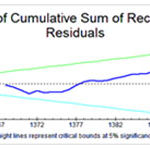 |
Fig. 1: Cumultaive sum of recurcive residuals (CUSUM) |
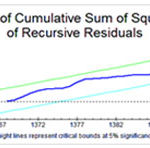 |
Fig. 2: Cumultaive sum of squares of recurcive residuals (CUSUMSQ) |
There are various indexes for measuring aggregate support policies. In this study, regarding the more comprehensive data to other aggregate support policy indexes, (AMS) is used. This index based on international business organization law is applied to measure and evaluating the member countries’ duties. To measure standard support, all national supports influencing price and products’ scale are considered except market supports that are achieved by consumption edge control. Standard support is first measured for a single basic agricultural product and then a similar measurement is done for general inapplicable supports to the product. Then by adding them together, Total Aggregate Measurement of Support (TAMS) is achieved. Total Aggregate Measurement of Support approach is as followed:
…(3)
In equation 3 we have
While TAMS is the Total Aggregate Measurement of Support, AMSi is the total aggregate measurement of support of the product i, EMS is the Equivalent Measurement of Support of a specific product, Pid is the price of the product iin the country, Piw is the international price of product I,rjw is the international price of the inputj, rjw is the price of inputjin the country, e is the exchange price, Qi is the quantity of product I including support prices, qj is the input j quantity including subsides receiving, Sij is the amount of paid subsided to the inputj related to product I (Gilanpour, 2012).
Amount of food security index was measured by Mehrabi and Mousavi (2010) during the period of (2006 – 1983) using (AHFSI) and we have just measured this index again until 2012. Required data and information for this research was educed from Statistical Center of Iran, CPPO and Central Bank of the Islamic Republic of Iran between (1982-2012) as the basic price of the year 1997. To analyze and investigate the research results, Microfit 4.0andEviews 8.0 softwares have been utilized.
Results and Discussion
To evaluate the effect level of aggregate support on urban household’s food security in Iran first the stability of variant’s conditions. Variant’s stability results using Dicky Fuller test is generalized. Table (1) shows that variants of the urban household’s food security and inflation rate are stable. And the total standard aggregate index variant is almost the most stable index.
Table 1 : Unit Root Dicky Fuller Test Results
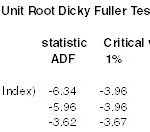 |
Click here to view full table |
Stable Pattern Estimation ResultsAs in pattern (1), there was a combination of variants I(0) and I(1), for analyzing short-term and long-term relations between variants, Pesaran and Pesaran (1997) approach has been applied. The above-mentioned approach represented by these two researchers which is called (ARDL). Advantage of using this model rather than other ones is that regardless to the stability of variants I(0) and I(1), convergent relation between the variants can be gained. In addition, for smaller scale cases, this approach enables more elaborate approach to target potentials than the others. Therefore results of the ARDL approach because of the prevention of problems such as self-correlation or introspection are non-oblique and applicable. Besides, this approach estimates long-term and short-term relations between dependant variants and other pattern elaborative variants simultaneously. Therefore as variants are not stable at the same level, to estimate the model, self-elaborative pattern by vast pauses (ARDL) are used. Therefore to estimate the concerned model, the most number of pauses is one; because pause 1 led to a better estimation of the pattern. Besides, considering the number of included data which is less than 100, Schwartz Bayesian Criterion (SBC) is used.
Stable Pattern Estimation Results of ARDL is shown in table (2). Based on the results, urban household’s food security index by a pause is meaningful by a positive sign on line five. Variant coefficient of total aggregate support criterion index is also meaningful statistically on one percent level and is meaningful by a positive sign. Variant coefficient of inflation index and virtual variant of subsides purposivism in Iran is meaningful statistically on five percent by a negative sign.
Table 2: stable pattern estimation results
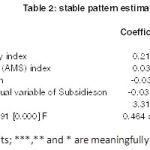 |
Click here to view full table |
Diagnostic test and stability of structural model results
Based on the stable pattern estimation results, absorption coefficient wellness is 53 percent which shows the power of variant elaborateness in this model. Estimated F of the total model measured is statistically at the assuring meaningful level of 99 percent and is the representative of variants’ effects on the pattern. the amount of statistic H-camera is also 0/515 that for the locating position of ±1/96, we cannot ignore the non-existence of correlative theory. Therefore this pattern is not faced with a non-existence of the correlative theory.
To assure the creditability of the pattern under study, diagnostic test of table (3) have been utilized. Results of Anova and LM test prove all classic hypothesis indefeasibility. Then not having any problems of both correlation or variance inequality and the definite form and error sentences are distributed correctly and normally and the credibility of statistical results is proved. Therefore to prove pattern coefficients, CUSUM andCUSUMSQ tests are applied. According to tables (1) and (2) statistics of the above-mentioned tests are in the straight lines and the results of this test shows the stability of the estimated coefficients and for the locating position around the assured range of 95 percent, there is no structural failure in this model.
Table 3: diagnosis test’s results
 |
Click here to view full table |
Long-term pattern survey results
To investigate the existence of co-integration of the computational t-test (-7/90) regarding absolute value of critical quantity by Benerjee, Dolado and Master is (-4/29) more at the assured level of 99 percent. As a result, it can be concluded that there is a balanced long-term relation between the pattern’s variants in this study. Results of this long-term relationship are represented in table (4). Based on the results in long-term, aggregate support amount at level one is statistically meaningful by a positive sign. Therefore one unit increase of aggregate era in Iran increases urban household’s food security index to ./.43 unit. Variant coefficient of inflation index as expected by a negative sign is meaningful at level five. One unit increase of inflation rate index of urban household’s food security index in Iran will be decreased to ./.43 unit. Virtual variant’s coefficient through the years of the execution of the subsides purposivism law is also meaningful by a negative sign at the level of ten percent. Results show that in long-term, execution of the subsides purposivism law in aggregate era causes a reduction in farmers’ activity sector due to agricultural input prices and energy carriers. Consequently there the reduction of the food production in the country occurred.
Table 4: long-term pattern estimation results
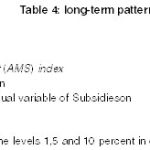 |
Click here to view full table |
Error correction model results
Error correction model results are represented in table (5). Results show that in short-term like long-term, variant coefficient of the aggregate support is positive and inflation rate variants and virtual subsides purposivism variants are meaningful by a negative sign. Just that in short-term in relation to long-term, there was a reduction of the coefficients. Based on the error correction coefficient test ECT(-1) is meaningful and has negative sign. Its coefficient shows that every year ./78 percent of unbalanced period in urban household’s food security index is reduced in the next period. Besides, reverse of this coefficient shows the acceleration of the model variants’ efficiency on urban household’s food security index in Iran; in the other words, to reduce the total results of the execution of any policies, less than 1/5 year is needed that the proper time period with respect to the considered pattern is short along with a high reduction acceleration and idealistic.
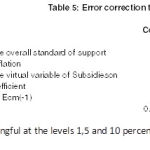 |
Click here to view full table |
Conclusion
In this study, government’s efficiency in aggregate support on urban household’s food security index in Iran through (2012 – 1982) is investigated using self-elaborative pattern by vast pauses (ARDL). Research results showed that in short-term and long-term, aggregate support index has had a positive effect and meaningful on urban household’s food security index in Iran. Therefore, improvements on support policies and planning a purposive policy to a positive impact on country’s food security seem to be essential. According to the inflation rate results and virtual variants of the years of subsides purposivism law execution in short-term and long-term, there was a negative impact on urban household’s food security index.
In this research, with respect to the results, for the improvements of urban household’s food security in Iran, can investigate two issues on support policies and subsides purposivism law execution in Iran.
Targeting subsidy plan as one of the most influential and crucial developmental steps in Iran’s economy has been legislated for the execution in the priority list of the tenth parlimantaries and was executed in the framework of the economical change schedule in 2010. This plan was executed while the economy of Iran by managing the inflation rate had faced slump and economical growth reduction. Besides, range and aspects of subsidy and its consequences on economy and government’s budget was extremely high. As a result of the targeting subsidy law execution in the beginning years, there occurred a negative impact on aggregate sector. Increase in the various steps of the production (such as energy carriers’ price, inputs, agricultural mechanization services, marketing services and etc.), imbalanced increase of the product purchasing along with production costs and dealer numbers increase consequently an extremely high increase in the products’ prices became a great shock in the product and consumption sector as many producers of aggregate sector has decreased their production quantity to reduce their economical loss. In the other hand, due to increase of food product prices, urban household’s ability to buy them reduced. Therefore, these two issues caused the reduction of bourgeois and vulnerable household’s food security reduction in Iran. One of the causes of this negative effect could be the dependency of the agriculture of Iran to the governmental aggregate support which is the supreme need to the growth and development in this era. As before the targeting subsidy law execution, main conditions and structures of agricultural sector such as land consolidation, mechanization development, agricultural research quality increase, marketing services advancement, balanced product price appointments by market mechanism and etc. should be created.
Based on the research results regarding the positive impact of the aggregate support policies for the improvement of the urban household’s food security, the need for the improvement, efficiency increase and the variety in aggregate support policies is considered. Therefore, suggestions that lead to improvements of the aggregate support in agricultural sector are referred in this era.
Applying the product cost reduction policies and producer’s revenue increase through technical and technological progress in various steps of production and necessary computing facility services to farmers for empowering and advancement of the agricultural mechanization will be provided. Therefore increase in the technological usage for the agricultural production will lead to revenue progress and agricultural sector growth while this progress helps the improvements of the household’s conditions. As income increase is aligned with the food product price reduction and more demand on the dealing goods and services which ultimately has a positive effect on producing condition and food security in the country.
Regarding input support through allowance of the high quality input such as improved seeds and healthy muck can help the improvement of the aggregate support policy and agricultural product sector.
Agricultural insurance is also one of the other guidelines for aggregate support policies which assists the improvements of food security condition. Agricultural insurance by providing security and opposing a lot of risks that threatens investment in agricultural sector helps farmers to plan a management at the lowest risk level and stable strategies for a better productive purposes.
Applying proper price supports through on-time and optimum appointments of guaranteed price policies, on-time product purchasing and purchasing price preferences based on the product quality can cause an increase in a more attention, efficiency, quality and encouragement of the farmers to produce more high quality, healthy and nutritious products.
After all , investment increase in research sector, variety creation in educational guidelines such as (expository farms, audio-visual movies, copying, publishing and representing research results for the producers, marketing teaching classes, getting to know organic farming, informing farmers about the standards of healthy food producing) are instances of positive governmental moves in aggregate support policy era which leads to the achievement of more and higher quality productivity by a lower cost which concludes in the achievement of positive effects on food security.
References
- Babatunda R B, Qaim M. Impact of off-farm income on food security and nutrition inNigeria. Journal of Food Policy. 35: 303–311 (2010)
- Bashir M Kh, Schilizzi S, Pandit R. The determinants of rural household food security on the Punjab, Pakistan: an econometric analysis. School of Agricultural and Rresource Economics (2012).
- Bigman, D., the measurement of foodsecurity, In: Berck, P. / Bigman, D(eds.1993): Food security And FoodInventories, In Developing Countries,Wallingford: CAB International, 238-251 (1993).
- Byres, T. J ,« Agrarian Transition and the Agrarian Question, in j. Harriss (ed.), Rural Development, London: Hutchinson University Library» (1982).
- Car, B. The economics of agricultural policy. CRS Report for Congress, pp: 92 – 108 (1992)
- Del Ninno, C., and Dorosh, P. A., and Kalanidhi, S. Food aid, domestic policy and food security: Contrasting experiences from South Asia and sub-Saharan Africa, Food Policy 32, 413–435 (2007).
- Farajzadeh, Zakaria. Najafi, Baha aldin. Effect of food subsidy Reduction on Iranian onsumers. Journal of Iranian Economic Research, Allameh Tabataba’i University, 6(21), pp. 135 – 156 ((2004)).
- Faridi, R., and Wadood, S. N. An Econometric Assessment of Household Food Security in Bangladesh, The Bangladesh Development Studies, Vol XXXIII, September 2010, No 3 (2010).
- Food and Agriculture Organization of the United Nations (FAO). “Rome Declaration on World Food Security and World Food Summit Plan of Action”. World Food Summit, Rome, Italy: FAO, Retrieved November 2014 (1996).
- Food and Agriculture Organization of the United Nations (FAO). Implications of Economic Policy for Food Security: A TrainingManual (1998)
- Gilanpour, Omid. Calculation of Aggregate Measurement of Support (AMS) in Iran’s agricultural sector, Agricultural Planning, Economics And Rural Development Research Institute. Tehran. Iran (2012)
- Godo, Yoshihisa, Evaluation of Japanese Agricultural Policy Reforms under the WTO Agreement on Agriculture. International Association of Agricultural Economists. 2012 Conference, August 18-24, Foz do Iguaçu, Brazil (2012).
- Hosseini, Seyed. Safdar., Pakravan, Mohammad. Reza., Gilanpour, Omid., and Atghayi, Milad. Investigating the Effects of Protection Policy on Agriculture Sector TFP, Journal of Agricultural Economics and Development, Ferdowsi University, 25(4), PP. 507-516 (2011).
- Kassie, M., Ndiritu, S. W. and Bekele, A. S. «Determinants of Food Security in Kenya, aGender Perspective». 86th Annual Conference, April 16-18, 2012, Warwick University, Coventry,UK. o. 135124. Agricultural Economics Society, 2012 (2012).
- Kazemnejad, Mahdi, The Analysis Obligation of Support on the Agricultural Sector in IRAN & WORLD (Theory, Lesson of World Experiences, Approach), Iranian Journal of Agricultural Economics. Iranian Agricultural Economics Society, 8, Special Issue, Pp. 205-216 (2014).
- Leeuwis, C., Communication for Rural Innovation: Rethinking Agriculture Extenstion. Wageningen: Wageningen Agricultral University (2003).
- Mehrabi Boshrabadi, Hosein., and Mousavi Mohmmadi, Hamideh. Effects of Government Protections in Agricultural Sector on Food Security of Urban Households in Iran, Iranian Journal of Agricultural Economics. Iranian Agricultural Economics Society, Vol. 4, Issue 3, Page 1-16 (2010)
- Mehrabi Boshrabadi, Hosein., and Mousavi Mohmmadi, Hamideh. Analysis of Agricultural Protection Policies Effects on Food Security of Rural Household in Iran. Quarterly journal of Agricultural Economics and Development, Agricultural Planning, Economics And Rural Development Research Institute of Iran, 18(70), 175-192 (2010)
- Misselhorn, A; Aggarwal, P; Ericksen, P; Gregory, P; Horn-Phathanothai, L; Ingram, J& Wiebe, K. A vision for attaining food security. Environmental Sustainability, 4, pp. 7-17 (2012).
- Moghadasi, Reza. Sherafatmand, Habibeh. Surveying the Effect of Subsidies on Total Factor Productivity in Agricultural Sector. Quarterly journal of Agricultural Economics and Development, Agricultural Planning, Economics And Rural Development Research Institute of Iran 20, No.77 :201-216 (2012)
- Pesaran. M. H. and Pesaran. B. Working with microfit 4.0: An introduction to econometrics. Oxford University Press (1997).
- Pinstrup-Andersen P, Pandya-Lorch R. Prospects for future world food security. IRDCurrents: Current Issues in International Rural Development. No: 9 (1995).
- Salem, Jalal. Mojaverian, Mojtaba. The Study of Food Import Capacity Effects on Rural Households’ Food Security in Iran, International journal of Agronomy and Plant Production, 4 (6), 1234-1240, (2013)
- Santeramo, Fabio Gaetano. On the composite indicators for food security: Decisions matter!, Munich Personal RePEc Archive (MPRA), No. 58955, posted 29. September 2014 13:50 UTC, Online at http://mpra.ub.uni-muenchen.de/58955 (2014)
- Sekhampu, Tshediso. Joseph. Determinants of the Food Security Status of Households Receiving Government Grants in Kwakwatsi, South Africa, Mediterranean Journal of Social Sciences, 4 (1) January 2013, 147 – 153 ((2013))
- Sen A.K. Poverty: An ordinal approach tomeasurement, Econometrical, 44, PP.219-231 (1976).
- Thomson, A. and Metz, M., “implicationof economic policy for food security”. ATraining Manual. FAO, Rome (1998)
- Wineman, Ayala, Multidimensional Household Food Security Measurement in Rural Zambia, the Agricultural & Applied Economics Association 2014 AAEA Annual Meeting, Minneapolis, Minnesota, July 27-29, (2014)
- World Bank. Poverty and hunger: Issues and options for foodsecurity in developing countries, World Bank policy study (1986).
- Yavari, Gholamreza., Hosseini, S.Asieh., Fazelbeygi, M. Mehdi., Estimation of Food Securityin Iran Based on the Main Food Groups, Indian Journal of Applied Research, 4(5), p. 263 – 265 (2014).
- Zhai, K, «Vision of Resource, Structure, System and Chinese Food Security». IERI Procedia, 4; 408-416 (2013).







